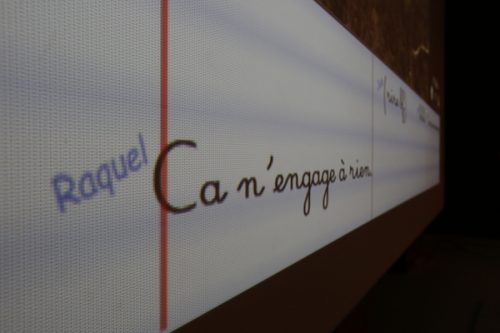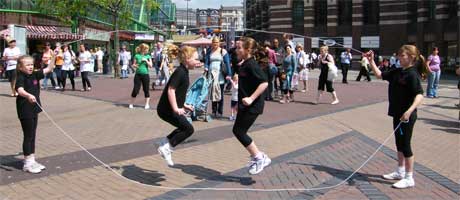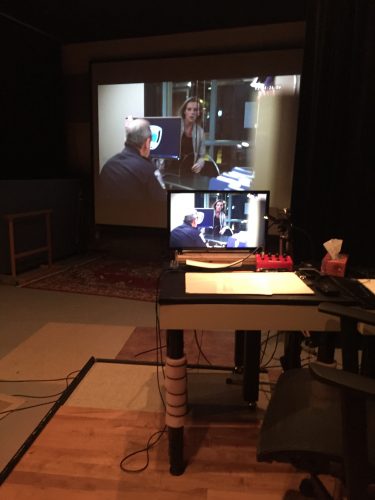Audio Dialogue Replacement, (ADR) or looping, has come Poor quality of ADR dubbing in old School kung fu movies a long way since the old-school Kung Fu movies where the mouth movements and dialogue didn’t match. Dubbing is the unglamorous low man on the totem pole in the voice world. Not as prestigious as cartoons or videogames, not as lucrative as commercials or TV narration, it still requires a very specific talent. Matching and timing what comes out of your mouth with what shows up on screen. And if you nail it, you’ll find yourself invited into this weird world of post-production work and vehemently asked to stay. And what voice actor in their right (or left) mind doesn’t love a regular gig.

I first got into dubbing a short lifetime ago, by sitting in and watching cartoon dubbing to a rhythmo band for a few weeks. The series had originally been written and animated in France and the post production house wrote an English version. I pitied the poor writer, who I occasionally visited as they painstakingly watched the film, and marked down anytime a character’s lips came together fully in bilabials (b, p, m) or partially, in semilabials, (f, v, wh, r). Then, they took the translated dialogue and came up with a suitable substitute in English that matched the constraints of the story, character and the mouth flaps.

In the dubbing studio, the director cast me in a few minor character roles for my entry job and got up and stood at the bar. I found it kind of like jumping rope. Double Dutch style. Just jump in and do it. If you mess up, do it again. But really try not to mess up, because the director is on a schedule and has to finish the episode today. It requires concentration to stay in character and hit your vocal mark, making sure you bring your lips together at the right time to match those labials correctly while still giving your performance justice. Like a commercial, you are cold reading. Nobody gets the script ahead of time. And like so much of performance work, you’ll be exhausted when you’re done, but so happy you hit it in sync.

Walla is another type of ADR I happily do regularly. Walla is those non-specific background sounds made by actors that were not miked when the film was rolling. It looks weird if you see someone in the scene talking, but hear nothing, so we are brought in to color and heighten the soundscape. A team (often 3-4 guys, 3-4 gals) of performers arrive at a post-production studio. We stand at a post and adlib monologues and dialogues to cover certain scenes that people in the background. Bars, hospitals, police stations, coffee shops, offices, that sort of thing. Sometimes the language is specific, like for an airline crash or a period piece. Sometimes it’s very general. A wipe across the screen indicates when you start and stop.
 Another cool type of dubbing I’ve done a lot of is called versioning. This is usually seen in documentaries, when a series has been shot in another language and the interviews have been translated. You hear some of the original voice in the foreign language and then the versioned voice comes in. While obviously not the same person, the voice actor who does versioning approximates the pitch, rhythm and emotional state of the onscreen character. Some countries call this re-voicing and others call it phrase sync.
Another cool type of dubbing I’ve done a lot of is called versioning. This is usually seen in documentaries, when a series has been shot in another language and the interviews have been translated. You hear some of the original voice in the foreign language and then the versioned voice comes in. While obviously not the same person, the voice actor who does versioning approximates the pitch, rhythm and emotional state of the onscreen character. Some countries call this re-voicing and others call it phrase sync.
I’ve actually never done looping for my own characters. I guess my on screen acting jobs were so small they didn’t need audio replacement! Looping is when actors re-record their lines in post-production with better audio, while watching their original performance looped in playback. The sync is tight or loose depending on whether the actor’s mouth is on or off camera. Some pretty memorable performances have been completely looped without a mouth on cam, like Darth Vader.
 Lip syncing is a subset of looping. I think this is the most demanding of this form of voice over footage that’s already been shot. It’s a tight, precise match. Every time I’ve done lip sync it’s been for commercials and there has been no wipe or rhythmo band. It’s been all me, baby. To get the match, you have to internalize the rhythms of the original phrase. An elongated vowel here, an abrupt intake of breath, or enunciation there. The match has to be on point in tone, speed and personality while reading the lip movements for sync. I credit my facility with tight lip sync to lots of practice at Mirror Speech, a Viola Spolin improv game. If you don’t know it, it’s a game played with two actors where one initiates an ad-lib and the other mimics them in sync, then they switch and the second actor initiates the direction of the ad lib and the first one follows.
Lip syncing is a subset of looping. I think this is the most demanding of this form of voice over footage that’s already been shot. It’s a tight, precise match. Every time I’ve done lip sync it’s been for commercials and there has been no wipe or rhythmo band. It’s been all me, baby. To get the match, you have to internalize the rhythms of the original phrase. An elongated vowel here, an abrupt intake of breath, or enunciation there. The match has to be on point in tone, speed and personality while reading the lip movements for sync. I credit my facility with tight lip sync to lots of practice at Mirror Speech, a Viola Spolin improv game. If you don’t know it, it’s a game played with two actors where one initiates an ad-lib and the other mimics them in sync, then they switch and the second actor initiates the direction of the ad lib and the first one follows.
A long time voice actor, I love pretty much every aspect of voice work including dubbing. What’s your fav?
